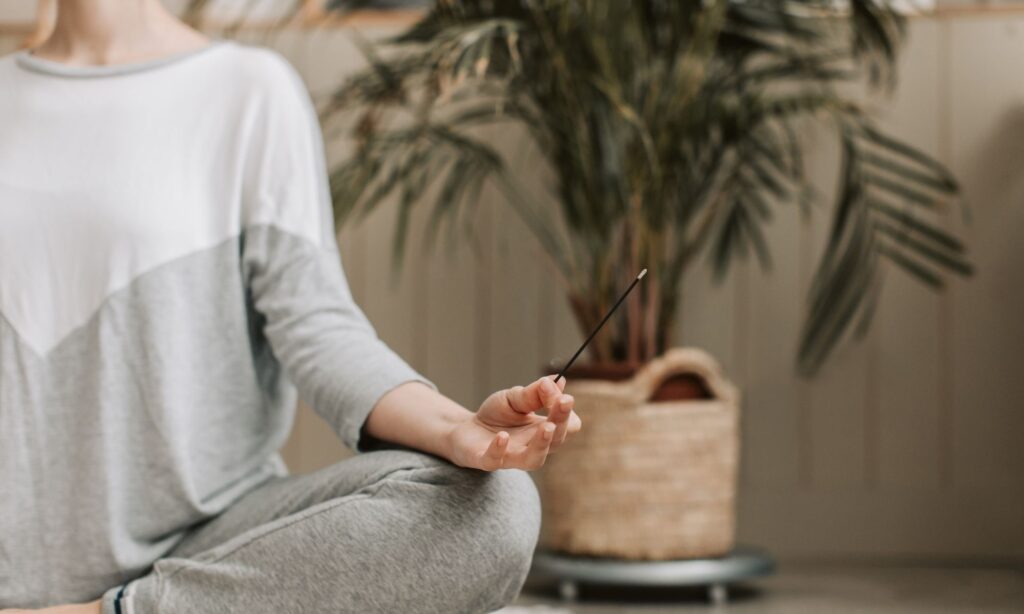Be Here Now: How Mindfulness Transforms Your Mind & Life

Table of Contents
In a world addicted to speed, stimulation, and endless scrolling, the idea of simply sitting still and breathing can feel foreign, even uncomfortable. But the very discomfort that arises when we pause is the gateway to transformation.
Mindfulness, once a niche concept rooted in Eastern philosophies, has now become a scientifically backed method for improving mental clarity, emotional well-being, and physical health. From reducing stress to enhancing creativity, the benefits of mindfulness are vast – and they’re accessible to anyone willing to pause and pay attention.
This article is your guide to understanding what mindfulness really is, how it works, and most importantly, how to make it part of your everyday life. Whether you’re brand new to the practice or looking to deepen your connection to the present moment, you’ll find practical tools here to support your journey.

Understanding Mindfulness
At its core, mindfulness is the practice of bringing your full attention to the present moment – with openness, curiosity, and without judgment.
It means observing your thoughts without becoming them. It’s feeling your feet on the floor, hearing the tone of a loved one’s voice, or noticing the way the sunlight hits your window. It’s life as it is – not how we wish it would be, not how it was yesterday, not how we fear it will be tomorrow.
Where Does Mindfulness Come From?
Though mindfulness has surged in popularity in recent years – appearing in workplaces, schools, apps, and therapy rooms – its roots stretch back thousands of years.
Mindfulness as we know it today originates from ancient Eastern traditions, particularly Buddhism, where it was practised as part of the Eightfold Path. It’s known as sati in Pali, meaning awareness, attention, and remembering to be present.
One of the most influential lineages in mindfulness is Zen Buddhism, which brings a beautifully minimalist approach to presence. In Zen, the emphasis is not on thinking your way to peace but experiencing it directly. Whether it’s sipping tea, raking leaves, or sitting in silence, Zen teaches that every act – no matter how ordinary – is an opportunity to awaken.
Zen doesn’t offer step-by-step instructions. Instead, it invites you to experience life as it is, beyond labels and analysis. Its teachings often come through short, paradoxical stories or koans that challenge habitual thought patterns and bring you into the now.
In recent decades, teachers like Thich Nhat Hanh and Jon Kabat-Zinn have helped bring these concepts into the Western world in practical and secular ways. Kabat-Zinn’s development of Mindfulness-Based Stress Reduction (MBSR) in the late 1970s helped mindfulness become a widely respected method for reducing stress and improving well-being, both physically and emotionally.
Whether through ancient Zen stories or modern scientific studies, the message is the same: mindfulness is the art of coming back to yourself, again and again, with awareness, acceptance, and presence.

What Science Says About Mindfulness
Research over the last two decades has shown that regular mindfulness practice can:
- Lower cortisol levels (the stress hormone)
- Improve memory and focus
- Enhance emotional regulation
- Reduce symptoms of anxiety and depression
- Increase compassion and empathy
Brain scans even show increased activity in the prefrontal cortex (decision making, attention) and decreased activity in the amygdala (fight or flight) among regular practitioners.
And yet, mindfulness isn’t about becoming someone new. It’s about reconnecting with what’s already here – your breath, your body, your presence.
The Power of Mindful Breathing
If there’s one anchor in mindfulness that you can always return to, it’s your breath.
Breathing is the only autonomic function we can control voluntarily. And that makes it the perfect tool for training attention and calming the nervous system.
What Is Mindful Breathing?
Mindful breathing means tuning into the natural rhythm of your breath, without trying to change it. It’s noticing how the air enters your nose, fills your lungs, and gently exits your body. It’s becoming a witness to something you usually take for granted.
Simple Breathing Techniques to Try
Here are a few easy ways to begin:
Box Breathing (4-4-4-4)
- Inhale for 4 seconds
- Hold for 4 seconds
- Exhale for 4 seconds
- Hold for 4 seconds
Repeat 4–5 rounds
This technique is commonly used by athletes and Navy SEALs to remain calm under pressure.
Counting Your Breaths
Breathe in naturally and count “one.”
Exhale and count “two.”
Continue up to ten, then return to one.
If your mind wanders (which it will), gently bring it back without self-judgment.
Noticing the Pause
Notice the tiny pause between inhale and exhale – that moment of stillness. This helps you settle deeper into the now.
Why It Matters
In just a few minutes, mindful breathing can:
- Lower your heart rate
- Bring you out of a stress spiral
- Anchor your awareness to the present
Whether you’re at your desk, in traffic, or lying awake at night, your breath is always with you – a portable refuge.

Embracing Gratitude Through Journaling
If mindfulness is about presence, then gratitude is about recognising the value of that presence. It shifts your attention from what’s missing to what’s already here – and that simple redirection can change everything.
Why Gratitude Works
Gratitude isn’t just a feel-good buzzword – it’s backed by neuroscience. Regular gratitude practice has been shown to:
- Improve sleep
- Boost mood and mental health
- Strengthen relationships
- Increase resilience and optimism
In mindfulness, gratitude becomes a lens. Instead of chasing the next achievement or comparing your life to someone else’s, you learn to notice small joys: the warmth of your tea, a kind word, the fact that you’re still here and trying.
How to Start a Gratitude Journal
You don’t need fancy tools or long writing sessions. Just a few minutes a day can create a noticeable shift. Here are a few prompts to help you begin:
- What are three things I’m grateful for today?
- What challenge taught me something recently?
- Who made me feel seen or supported this week?
- What beauty did I witness today, no matter how small?
- What moment made me smile today?
Make It a Ritual
Try writing in your gratitude journal each evening before bed. Pair it with a warm drink or soft lighting to make it a soothing habit. If you’re using a planner, reserve a small section each day for this. Over time, you’ll find your perspective softening – even on the hard days. This is why I included “What was the one thing that made you happy today” in my Undated Daily Planner, as well as a weekly journal of at least three things you’re grateful for.
Gratitude is not about denying your struggles. It’s about training your mind to also see the light – the good, the gentle, the quiet magic that coexists with the chaos.
The Art of Being Present
One of the greatest challenges of modern life is simply being here now. With phones buzzing, deadlines looming, and minds spinning, presence often feels like a luxury we can’t afford.
But in reality, presence is everything. It’s the root of connection, creativity, and calm. When you are present, you feel your life instead of watching it blur past you.
What Does Being Present Look Like?
It might look like:
- Truly listening when someone speaks, without planning your reply.
- Tasting your food, instead of eating while scrolling.
- Watching your thoughts pass like clouds, rather than chasing or judging them.
- Feeling your emotions without needing to numb or fix them immediately.
Presence is not passive. It’s the most powerful form of engagement with your life.
Zen and the Power of Now
Mindfulness finds deep roots in Zen Buddhism, where presence is not just a practice but a way of being. In Zen teachings, there’s a phrase: “Before enlightenment, chop wood, carry water. After enlightenment, chop wood, carry water.” The wisdom here? Enlightenment – or mindfulness – doesn’t make life different. It helps you show up fully for the life you already have.
Zen reminds us that simplicity is sacred. You don’t have to escape to a retreat to be present. The sacred is in the ordinary: folding laundry, feeling sunlight, breathing.
Quick Ways to Ground Yourself in the Moment
If you find your mind drifting (and it will), try these simple mindfulness cues:
- Name five things you can see, four you can touch, three you can hear.
- Wiggle your fingers or toes to bring awareness back into your body.
- Take three mindful breaths, slowly and deeply.
- Place your hand over your heart, and feel its rhythm.
These are micro-moments of reconnection – no meditation pillow required.
Let Go of the Guilt
Mindfulness isn’t about being present 24/7. It’s about noticing when you’ve drifted and gently guiding yourself back. The noticing is the practice.
So the next time you catch yourself zoning out, congratulate yourself. You just had a moment of awareness – and that’s where transformation begins.

Integrating Mindfulness into Daily Routines
One of the biggest misconceptions about mindfulness is that it only happens on a cushion, in silence, with incense burning. But real-life mindfulness? It lives in your routines.
Whether it’s your morning coffee, the school run, or a 10-minute break between Zoom calls, every part of your day can be an invitation to come home to the moment.
Morning Rituals with Intention
Start your day with presence rather than panic. Here are small, mindful habits you can build into your morning:
- Stretch and feel your body before reaching for your phone.
- Brew your tea or coffee slowly – inhale, sip, notice.
- Journal for five minutes on how you want to show up today.
- Set a mindful intention like: “Today I choose calm over chaos.”
Mindfulness in Motion
Your workday, chores, and errands can also become part of your practice. Try these:
- Focus fully on one task at a time.
- Pause between emails to take a single deep breath.
- Notice the sensation of warm water while doing dishes.
- Walk without your phone – just be present with your steps and surroundings.
Evening Wind-Down Practices
Evenings are a natural time for reflection. You might:
- Journal about what you noticed or felt today.
- Practise gratitude for even the tiniest wins.
- Light a candle and read a few pages of something nourishing.
- Use a mindful breathing technique as you lay in bed.
You don’t need more time – just more awareness in the time you already have. Mindfulness becomes a lifestyle when it’s woven into your ordinary routines, not separated from them.

Overcoming Common Mindfulness Obstacles
Every journey comes with resistance, and mindfulness is no different. If you’ve ever tried to meditate and ended up frustrated, distracted, or bored, you’re not alone.
Here’s how to work with common roadblocks:
“I Don’t Have Time”
You don’t need a 30-minute session. Start with 1–2 minutes. Breathe at a red light. Feel your feet while brushing your teeth. Mindfulness isn’t about duration – it’s about attention. (Remember my article about building habits, which recommends starting with 2-minute activities)
“I’m Bad at Meditating”
There’s no such thing. The goal isn’t to empty your mind – it’s to notice your mind. If you notice your thoughts 100 times during meditation, you’ve succeeded 100 times.
“It’s Boring”
Mindfulness is often boring at first, especially if you’re used to constant stimulation. But boredom is a doorway. Stay with it. Underneath boredom is peace.
“I Keep Forgetting”
Use habit stacking: pair mindfulness with something you already do.
- After brushing your teeth, take one mindful breath.
- Before each meal, pause and observe your food.
- Place sticky notes where you often rush, like your desk or dashboard.
“I’m Not Seeing Results”
Mindfulness works subtly. Don’t look for fireworks. Look for micro-shifts: a pause before you react, more awareness of your thoughts, a moment of calm where stress used to live.
Tools and Resources for Mindfulness Practice
You don’t need fancy equipment to practise mindfulness, but the right tools can support and sustain your commitment. Here are a few to explore:
Apps
- Insight Timer – Free access to thousands of meditations, courses, and talks.
- Headspace – Great for beginners with structured mindfulness journeys.
- Calm – Focuses on guided meditations, breathing, and sleep stories.
Books
If you’re ready to deepen your mindfulness practice, books can offer guidance, insight, and gentle reminders to return to the present. Whether you’re just starting out or looking to expand your understanding, these timeless works from renowned teachers provide practical tools and meaningful inspiration. From Zen stories to scientific meditation techniques, here’s a curated list of the most impactful mindfulness books – each with a unique voice and valuable lessons to support your journey.
- The Miracle of Mindfulness, by Thich Nhat Hanh
This book introduces mindfulness as a way of life, emphasising the importance of being present in every moment. Through simple exercises and anecdotes, Thich Nhat Hanh guides readers to cultivate awareness in daily activities, from washing dishes to breathing, fostering inner peace and clarity.
- Wherever You Go, There You Are, by Jon Kabat-Zinn
Jon Kabat-Zinn demystifies mindfulness, presenting it as an accessible practice for everyone. He offers practical advice on integrating mindfulness into everyday life, encouraging readers to embrace the present moment without judgment, leading to greater self-awareness and tranquility.
- Radical Acceptance, by Tara Brach
Tara Brach explores the concept of embracing oneself fully, combining mindfulness and self-compassion to overcome feelings of unworthiness and self-judgment. Through personal stories and guided meditations, she provides tools to break free from self-imposed limitations and live authentically.
- Mindfulness: A Practical Guide to Awakening, by Joseph Goldstein
Joseph Goldstein delves into the Satipatthana Sutta, providing an in-depth exploration of the four foundations of mindfulness. He combines traditional Buddhist teachings with practical guidance, offering readers a comprehensive roadmap to deepen their meditation practice and achieve insight.
- Mind Full to Mindful, by Om Swami
Om Swami presents mindfulness through the lens of Zen philosophy, emphasizing simplicity and presence. He shares personal experiences and practical exercises, guiding readers to transition from a cluttered mind to a state of clarity and peace.
- The Practicing Mind, by Thomas M. Sterner
Thomas Sterner discusses the importance of practice and patience in achieving goals, highlighting how mindfulness can enhance focus and discipline. He emphasizes staying present and embracing the process over fixating on outcomes, leading to improved performance and reduced stress.
- Zen Flesh, Zen Bones, by Paul Reps and Nyogen Senzaki
This compilation offers a collection of Zen stories, koans, and teachings that illustrate the essence of Zen practice and the path to enlightenment. The book serves as a spiritual guide, encouraging readers to reflect deeply and experience insights beyond conventional thinking.
- Ten to Zen, by Owen O’Kane
This book offers a simple yet powerful ten-minute routine designed to calm the mind and reduce stress. Drawing from mindfulness and therapy techniques, it helps readers build emotional resilience and clarity through daily practice, making mental well-being more accessible and achievable.
Disclaimer: As an Amazon Associate I earn from qualifying purchases.
Journals & Planners
- Use a gratitude journal to track daily reflections.
- Mindful planners (like my Undated Daily Planner from Poserlane 😉) include space for intentions, mood tracking, and mindfulness reminders.
Online Courses & Communities
- Look for MBSR (Mindfulness-Based Stress Reduction) programs online.
- Join mindfulness forums or Instagram accounts for inspiration and accountability.
Tools are not about perfection – they’re about support. Choose what feels helpful, not overwhelming.
Conclusion: Come Back to Now
If there’s one thing mindfulness teaches us, it’s this: now is enough.
You don’t have to wait until you’re less busy, more peaceful, or more “spiritual.” Your life, just as it is, is the perfect training ground. Right here. Right now.
- Start with your breath.
- Write down what made you smile today.
- Taste your food. Listen fully. Pause before reacting.
These moments are small, but they’re sacred. And when you live them mindfully, they start to change everything else.
Mindfulness won’t fix your life. But it will change your relationship to it. And sometimes, that shift is the most powerful change of all.
Frequently Asked Questions (FAQs)
What is the best time of day to practise mindfulness?
Any time that you can consistently show up. Mornings are great for setting the tone, but even a mindful lunch break or evening walk can be transformative.
How long should I meditate each day?
Start with just 1–5 minutes. The consistency matters more than the length. As it becomes a habit, you can gradually extend your sessions.
Can mindfulness help with anxiety and depression?
Yes, many studies show that mindfulness reduces stress, lowers anxiety, and supports better mental health. It’s even used in clinical therapies like MBCT (Mindfulness-Based Cognitive Therapy).
Do I need to sit cross-legged or chant?
No. You can practise mindfulness while sitting in a chair, lying down, walking, or even washing dishes. Comfort and awareness matter more than posture.
How do I measure progress with mindfulness?
Progress shows up as more awareness in everyday life – catching yourself before reacting, feeling more grounded, and becoming kinder to yourself.







